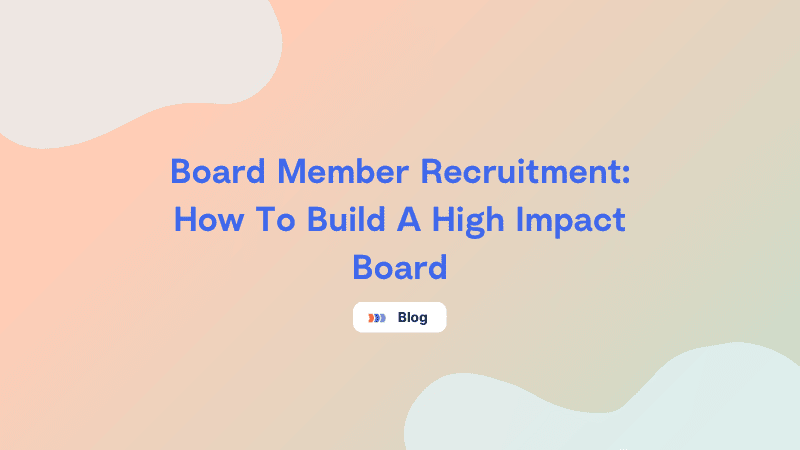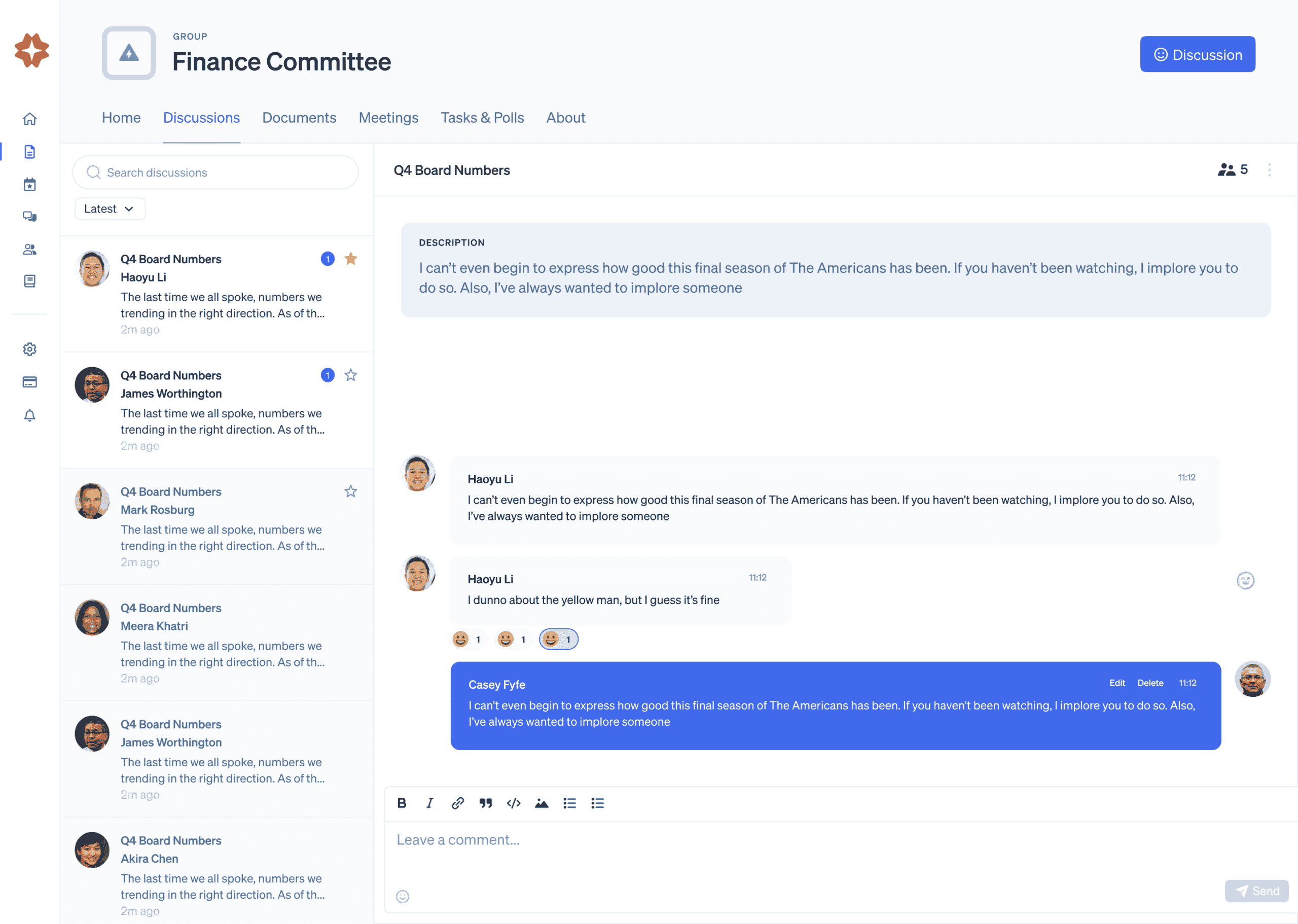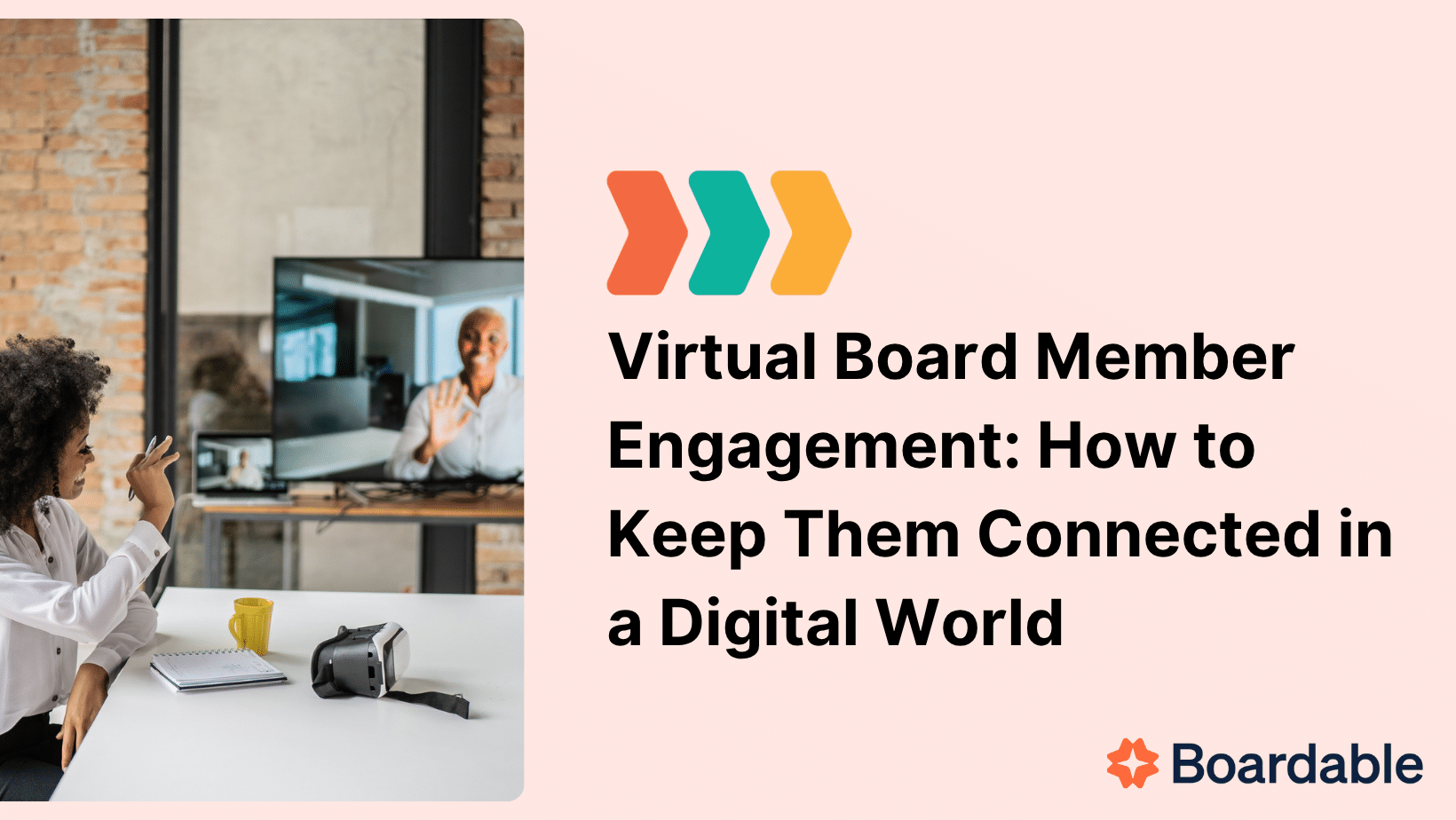A nonprofit board of directors is only as knowledgeable and effective as its board members. It isn’t easy to assemble a group of people who not only work well together but also have the right mix of skills and passion for the cause.
Making sure you always have great board member candidates in the pipeline requires effort and thought. Let’s look at some of the factors to keep in mind as your board plans board member recruitment.
These are the topics we will cover in this article. Feel free to skip to one of the sections below.
- What Is the Nonprofit Board Member Recruitment Process?
- What Qualities to Look for When Recruiting Board Members
- Nonprofit Board Member Recruitment Best Practices
- Conclusion & Additional Resources
What Is the Nonprofit Board Member Recruitment Process?
Nonprofit board member recruitment consists of identifying, approaching, and selecting a new member of the nonprofit board of directors. It sounds simple enough, but when it’s time to actually find a new recruit we often don’t know where to start. Here are the basic steps to figuring out who to reach out to and how.
Step #1: Determine what gaps need to be filled
Before you can start looking for the right nonprofit board members, you need to figure out what you want in a member. This will help to guide you throughout the board member recruitment process. Try an internal survey that assesses what skills or experience may be missing. A board full of lawyers or all creative types is probably not ideal.
Create and regularly update a rubric that tracks all of these items against current members’ terms, and identifies areas of future need. This tool should look forward at least three years.
Invite board members and staff leadership to identify potential board candidates. Nominations can be submitted through a document asking questions about leadership qualities, passions, experience, and future goals.
Step #2: Create accurate titles and descriptions
When discussing board openings, always make sure that the title you give to the role reflects the responsibilities included with the position. It is always best to create a listing that gives potential candidates an accurate picture of what you are looking for. For instance, you may want to specify that you are looking to recruit “a board member with marketing experience.”
Potential candidates for your nonprofit board want an accurate picture of what their responsibilities will be if they choose to take the position. Make sure that you create a description that provides enough detail and is also intriguing to candidates. Be sure to include some perks, such as a list of other board members they will have the chance to network with.
Step #3: Reach out to qualified prospects
If you want to find the best people for your nonprofit board, you need to reach out to potential candidates in as many ways as possible. Relying on candidates to come to you may mean you miss out on some of the best people.
Consider creating a listing on LinkedIn or a volunteer match website. Invite leaders from the community you serve to explore their interest in board service.
Step #4: Interview prospects.
Create a streamlined process for selecting, interviewing, and evaluating all potential candidates. Follow the process carefully to ensure both transparency and efficiency. This may include:
- Inviting prospects to attend a board meeting
- Asking them to volunteer an hour to see your organization
- Interviewing with a senior board member
Give the candidate a document explaining the responsibility of the board as a whole, such as this article by The Bridgespan Group. After that, another document that clearly outlines the responsibility required of the individual board member is helpful.
Step #5: Create a shortlist and make your final decision
Don’t rush through the decision-making process. Consider each candidate carefully and seek opinions from people who understand your nonprofit’s mission and goals. Once you have narrowed it down to two or three candidates, present them to your board for input. Someone might see a deciding factor that had been overlooked until then.
Step #6: Provide a formal orientation after induction
Once recruited and before inducted, begin orientation. This can be done in a number of ways:
- Providing materials such as a board manual
- Adding the new member to your board management platform
- Matching each new person with a mentor from the current board
- Inviting them to an organizational event
A formal orientation program is critical. Whether it’s a two-hour session or a two-day session, providing an overview of the organization’s history, evolution, philosophies, staffing, finances, etc. is key.
This is also a time to review the responsibilities of board members vs. staff. This sets a critical foundation for governance best practice and allows new board members to jump into meetings with a stronger knowledge base. Here is a new board orientation checklist created by BoardSource to be sure you have a successful transition.
What Qualities to Look for When Recruiting Board Members
Your nonprofit’s board is responsible for determining the organization’s direction and success. For this reason, it is essential to find the right people to take seats on your board. Below are some tips to help you make sure your nonprofit board recruiting is as strong and effective as it can be.
Knowledge
First and foremost, to recruit board members who can support your cause, you want to look for candidates who are well-acquainted with your organization and mission. Naturally, this will help whether you are making substantive changes or not.
No one can make a difference without fairly deep knowledge, so look for board members who have served on a similar board or who have been employed in a similar organization.
Additionally, your board member recruit may need specific professional or service-related knowledge that is lacking on the board. Bringing on someone with special knowledge of the geographic area, population served, and any other useful background info can be a game-changer.
Proactiveness, Patience, and Persistence
Most great board members are proactive. They ask the hard questions and perceive things about your organization that are not overtly obvious. They need to readily react to changes that may occur, but also must proactively work toward change, staying “on message” and on task to see the change through.
These board members are seen as strong proponents but not as overbearing ones, so they usually have the respect of the organization as a whole.
A new board member also needs to be patient, because change does tend to move at a slower pace in the nonprofit world. In short, dynamic board members need great people skills, with the ability to work with not only fellow board members but executive directors, staff, and external donors and stakeholders.
Time
One characteristic we often overlook is that the prospective board member must have the time to serve in the role. Make sure the candidate has the time to spare, given family and work commitments.
This seems obvious, but because board members are usually people who work to improve their worlds, they may have a tendency to overcommit. The best intentions in the world don’t go very far if the individual simply doesn’t have the time to give your organization.
Promoting Change
These days, most nonprofit boards can no longer afford to make slow changes. Rapidly evolving government regulations and technology are driving nonprofit boards to implement changes much more rapidly.
To be successful at it, executive directors must recruit and then retain change agents who can foster the change that the organization needs. Together, a visionary executive director and visionary change agents can navigate the organization well into the future.
Nonprofit Board Member Recruitment Best Practices
Okay, so we know what kind of individual is right for the board and the steps for identifying board candidates. But what are some ways to make these important practices more effective? Let’s look at some techniques to strengthen our board member recruitment endeavors.
Pay attention to small details
When evaluating candidates, don’t focus solely on their educational background or previous experiences. Listen to all of their responses to questions, and read between the lines when you receive written communications.
For example, if someone takes a long time to respond to your inquiries, it is a sign that the individual may not be reliable. Take a look at their work history and perhaps even do a social media audit to ensure there are no conflicts of interest or questionable past affiliations.
Aim for diversity
When creating a nonprofit board, you want a variety of different perspectives. Make sure each board member brings something different to the organization. This can be a challenge in nonprofit board member recruiting, but it is so important.
Remember, this is NOT just about ethnicity! A diversity of perspectives, backgrounds, experiences, and educations adds so much to your board’s ability to creatively solve problems.
Diversity, and just as importantly, inclusion, are separate topics deserving of specific attention and study. For more information on diversity in nonprofit leadership, check out this article.
Leverage your existing network
We all know that we can look to our colleagues and committee members for board member candidates. However, that tack is likely to produce very similar board members to our existing ones. There are two circles you don’t want to skip when looking for a potential director.
- First, look to your volunteers. These folks are already passionate about the mission and may even represent the community you serve. Circulate the director “job” description as if you were hiring paid staff and see what interest you get.
- Secondly, donors can be a perfect place to look for board members. Like volunteers, you know they already care about the work you do. Also, they should be an asset to your development efforts because they already know the case for financially supporting your organization. Think through your most loyal donors and evaluate if any of them are good candidates to approach.
Implement specialized tools
There are all kinds of tech tools you can use in your search for the next nonprofit board member prospect. Many nonprofits will now list board positions on LinkedIn, similar to a job posting.
This is a great way to catch people in a setting where they are used to looking for opportunities and professional growth positions. Others prefer to use volunteer matching sites like VolunteerMatch, Bridgespan or boardnetUSA.
You should also check with your local nonprofit agency to see if they have periodic volunteer and board member matching events. They might maintain a database of opportunities like yours, too!
Conclusion
Keeping the pipeline of excellent nonprofit board recruitment candidates full is a never-ending job. We are never done looking for the next great director, but if we can establish the habits in this article, each one will be easier to find than the last one was.
With attention to diversity, passion for the cause, and resources to share with the board, your leadership will continue to grow stronger every year.




